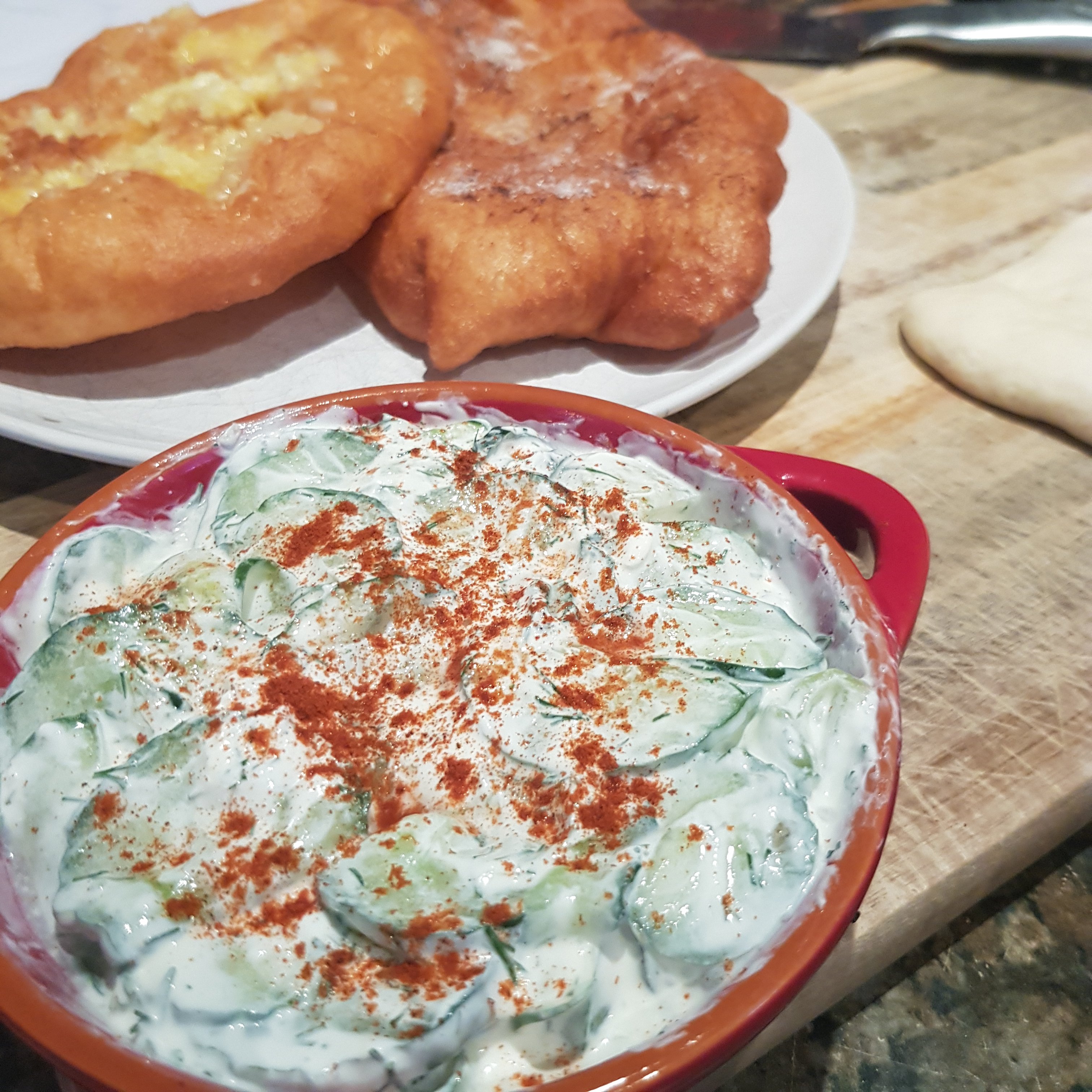Loving the personal connection to each of these, lately! Definitely a massive soft spot, is Hungary. My grandfather was Hungarian (well, technically Romanian because of a border dispute at the time of his birth, but he definitely spoke Hungarian and identified as such) and his legacy lives on in my weird last-name-that-is-a-first-name. I’ve always wanted to travel to the village where he was born, and will definitely do that with my Dad one day, but in the meantime my personal experience with Hungary is very limited. I’ve been there a couple of times, once on my own as a couch surfer and once with my wife and some friends.

Photo by Nikolett Emmert on Pexels.com
As a couch surfer, I stayed with a local on the outskirts of Budapest, which was a great experience. He was studying to be a tour guide (I didn’t know that was a vocation in and of itself) and delighted in showing me the absolute best of the city and giving me mind-boggling history lessons, wonderfully flavoured with huge discussions and amazing examples of one of my other loves – architecture. It was such a joy to see Budapest from so many different angles and I fell in love with it as a giant monument of sorts. The atmosphere, however, was overall fairly unwelcoming to be truthful. I struggled a little with the closed-off nature of many of the locals that I crossed paths with; my host described Hungarians as rude, xenophobic, homophobic and generally just disgusting, but I certainly wouldn’t use such emphatic language. I’d be more inclined to say that leftist or even just open-minded / progressive thinking was a bit of an undercurrent or a resistance to the general sentiment. I have two favourite memories, one of which (of course) relates to food. The first was attending the opera and buying the cheapest seats in the house (row 2 of the proscenium where you can’t see jack if someone sits in front of you) and hoping that the crazy-expensive front row seats didn’t sell. They didn’t, so don’t mind if we do, we moved forwards and had literally the best seats in the house for the price of a cup of coffee. I found this image on budapest.org and the seats we were in are at the arrow:
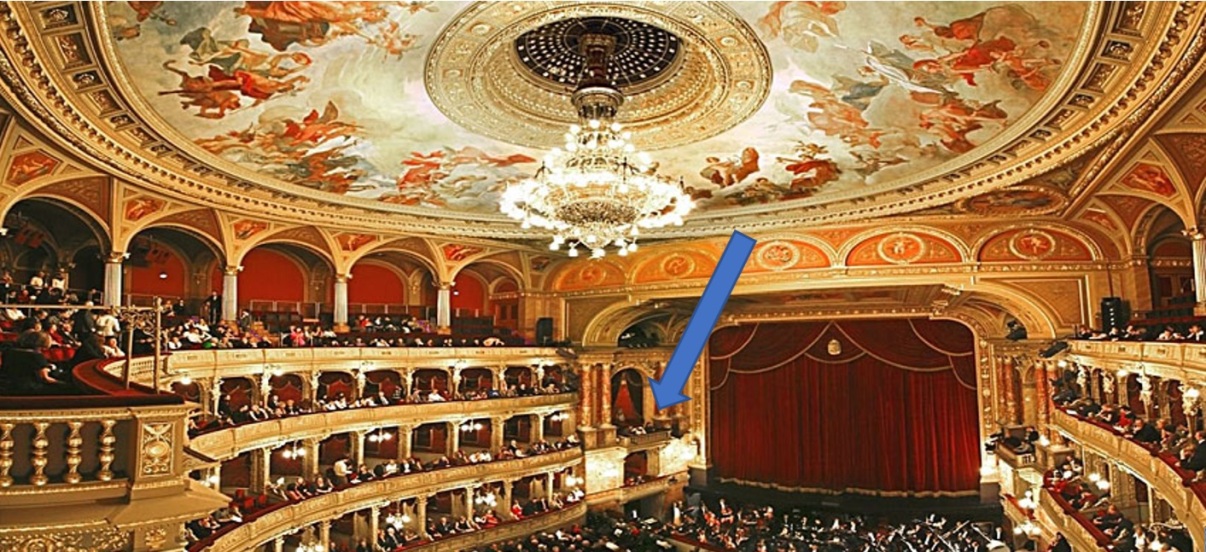
The other was visiting my host’s father who spoke very rusty Russian with me in his kitchen as he fed us soup and handed us a couple of bottles of hand-made stone-fruit Palinka (Hungarian version of fruit brandy). I wish I could also recreate the Palinka for this experience but for now it’s just stored in the ol’ memory files like so many things.

Photo by Szabolcs Toth on Pexels.com
Second time around was very different, in that my wife and I rented an Air BnB and delved a bit more into the ‘touristy stuff’ and ate out for every meal. As much as the train there was terrifying (Hungarian ticket inspectors refused to accept our perfectly valid Czech train tickets and we had to argue with them, then eventually buy new tickets, by speaking Czech to a Slovak-Hungarian guy who understood enough Czech to translate to the inspectors and then speak Slovak back to me to then translate (via Czech in my head) into English so my wife knew what was going on), once we got there all was forgiven. Instead of learning about ruin bars and the Jewish quarter, we drank there and ate at street markets. Instead of admiring the palatial public baths and the streets of the old town, we went to the cafes and soaked in the hot springs. It was a beautiful experience, and something I’ll remember forever. Definitely keen to go back one day and I am committed to exploring the countryside in future.
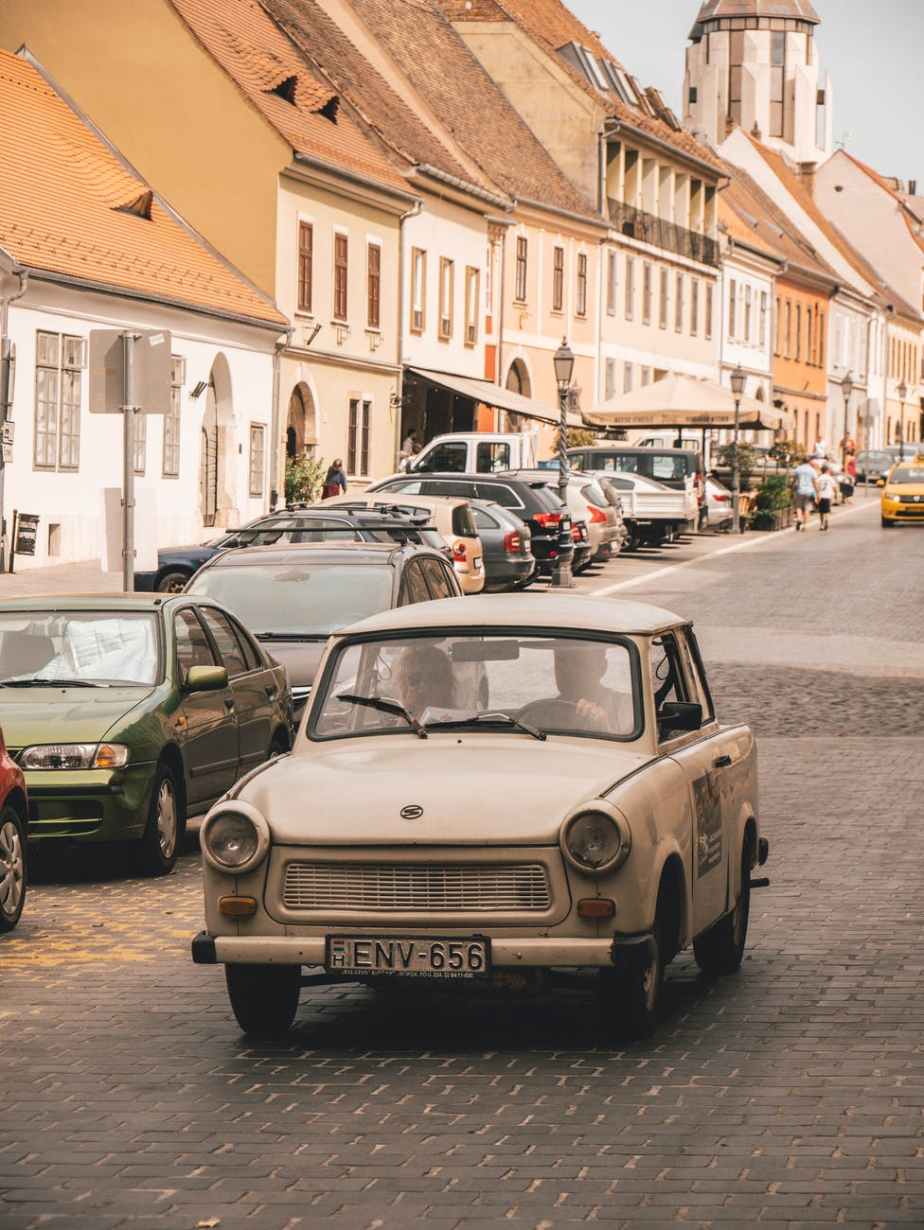
Photo by Alexander Naglestad on Pexels.com
Final story I have to tell involved an almost-third trip to Hungary. I woke up one morning to my wife asking “is it bad if I bought a dog last night while we were drunk?”. It took a while to make sense of the question, but I eventually elucidated that she’d contacted a vizsla breeder in the Hungarian countryside (they are Hungarian vizslas after all) and had her pick of the litter all agreed upon and put aside for us. It would have meant driving to Hungary (a full 2 countries away), which would have meant taking some time off work (which we didn’t have) and forking out over 1000 euros (which we didn’t have). But he was just so CUTE and we’ll love him and so on and so on. Unfortunately (?) reason got the better of us in the long run and we pulled the pin on it when we realised the cost and logistics of not only obtaining said puppy, but getting him home to Australia when we moved back. I felt terrible for the poor breeder and I’m sure the puppy found a beautiful home, but we’ve always pined for the trip-that-never-was and the puppy-that-never-was.

Photo by Nora on Pexels.com
What to cook was an easy question. Gulyas (or Goulash for Aussies, or Guláš for Czechs) is something we ate at least bi-weekly in Czech, likely due to the linkage between these countries (and Austria and Slovakia) under the Austro-Hungarian Empire. It’s the kind of thing that has evolved into countless variations over time (my favourite is actually a pork and sauerkraut version) in the countries it’s spread to, but I understand the ‘traditional’ version to be beefy, vegetabley, soupy rather than stewy, and laced with paprika in quantities some people might find obscene. It would traditionally be served with crusty bread or pinched noodles, but that depends who you ask because in Australia there are people who ‘traditionally’ serve it with pasta, or rice, or mash. I kept it simple and went with bread, because I didn’t want to overdo the starch when also serving a fried bread as part of the feast, but we’ll get to that.

Photo by Nikolett Emmert on Pexels.com
Gulyas
- 3 Tbsp lard
- 700g onion, chopped
- ¼ cup Hungarian sweet paprika (get the good stuff, imported from Hungary)
- 700g stewing beef, cubed (we used shin)
- 5 cloves garlic, minced
- 2 red capsicum, seeds and membranes removed
- 1 yellow capsicum, seeds and membranes removed
- 2 tomatoes, diced
- 2 carrots, diced
- 2 potatoes, diced (slightly smaller cubes than the beef)
- 5 cups beef stock (homemade is best, but liquid is plan B: don’t use powder)
- 1 bay leaf
- 1 tsp salt
- ½ tsp black pepper, ground
- Bread, sour cream & parsley, to serve.
- Melt the butter in a heavy-based pan, and soften the onions until they begin to brown.
- Remove from the heat and stir the paprika through.
- Add the beef and the garlic, return to the heat and cook for about 10 minutes until the beef is browned outside but not cooked through.
- Add the capsicums for a further 7-8 minutes, then add the remainder of the ingredients. Cover, reduce to medium and simmer for at least 40 minutes (we did 2 hours to get the softest, most tender beef we could)
- Serve with crusty bread and sour cream, sprinkled with parsley (optional)
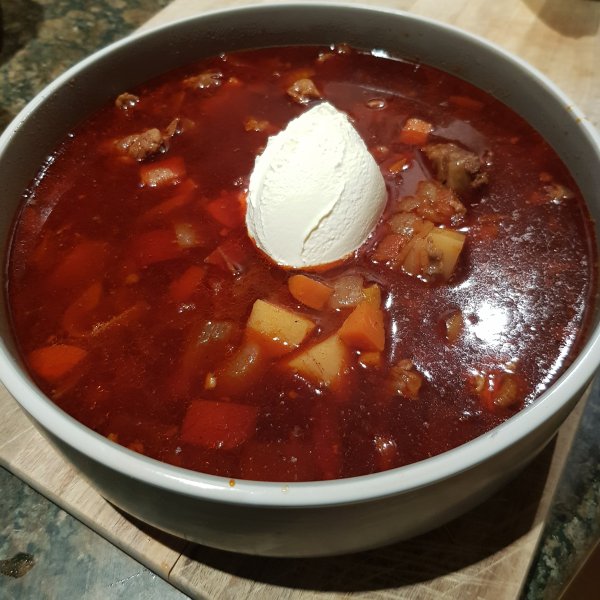
Lángos
For some reason this is insanely popular in Australia – every market I’ve been to has a stall selling Lángos. Surely there can’t be that many Hungarians in Australia to launch it to these heights? Maybe because it’s just bloody good? Fried bread smeared with garlic and melted cheese (optionally, sour cream or about 1001 varations) is happiness in anyone’s language I suppose.
- 1 large potato, boiled, mashed and kept warm (don’t use leftovers from the night before)
- 2 ½ tsp dried yeast
- 1 tsp sugar
- 1 ¾ cup plain flour
- ¾ tsp salt
- ½ cup milk
- Oil, for frying
- Either: 2 cloves garlic and 100g finely grated cheese or 20g cinnamon sugar
- Place the mashed potato, yeast, sugar, flour, oil, salt and milk into a mixing bowl of a stand mixer.
- Using the paddle attachment, combine until just mixed and everything’s slightly moistened.
- Change to the dough hook and knead for 5-7 minutes until the dough is smooth and elastic. It will be a bit sticky so use floured hands to transfer it to a greased bowl. Cover it with a damp towel and let it rise until double the size (mine took about 20 minutes)
- Divide dough into 4 pieces, shaping each one into a ball on a floured surface. Cover with the same damp towel and leave for a further 20 minutes to reinflate the air that was knocked out of it by moving it and dividing it.
- Heat oil in a deep frypan / wok.
- Flatten each dough ball to about ¾ cm thick, and slash the centre with three parallel lines to stop it inflating like a balloon in the oil (we want pizza-base shape).
- Fry each piece for 3-5 minutes each side, until lightly browned all over. Drain briefly on paper towel.
You can serve these however you like, but simple is traditional. We did a savoury version by rubbing a cut garlic clove all over (while still hot) and dumping the grated cheese on top, and a sweet version by sprinkling with cinnamon sugar (which is what my Dad remembers as a kid). You can just as easily use these as the base for all sorts of sweet or savoury concoctions, a bit like a pizza base or focaccia. The sky’s the limit!
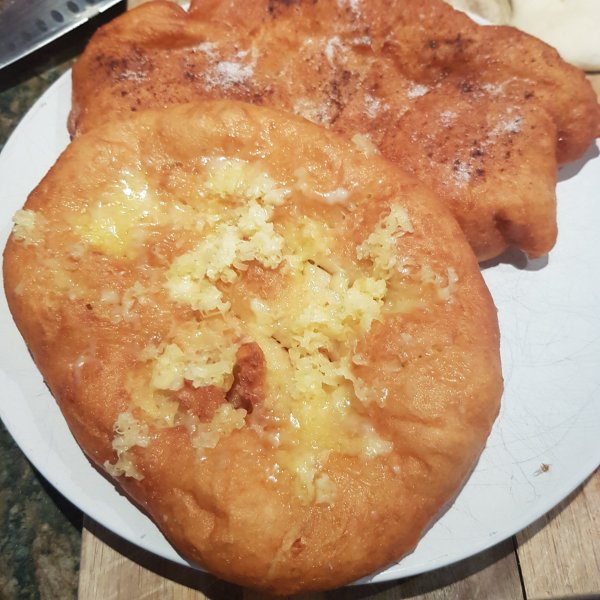
Uborkasalata
Nice and refreshing to counteract the rich and wintery gulyas.
- 4 large cucumbers (or 8 small)
- ¼ cup fresh dill, chopped finely
- ¼ cup salt (this seems like a lot but most of it will get washed off later)
- 300mL sour cream
- 2 Tbsp white vinegar
- 2 garlic cloves, crushed
- 1 tsp paprika (the good stuff that you used for the gulyas)
- Slice the cucumbers very thinly (and evenly), preferably using a mandolin.
- In a colander, place a layer of cucumber slices, then sprinkle them evenly with salt. Repeat layer by layer until all the cucumbers and salt are used up. Cover with a plate and put some heavy weights (e.g. tomato tins) on top. This will lose a lot of water, so ensure it’s in a large bowl or in the sink. Sit for 1 hour, undisturbed.
- Take out the cucumbers, a handful at a time, and squeeze out as much water as you can manually. Rinse them well to get rid of the excess salt.
- Return the cucumbers to the colander and put the weighted plate back on top for a further 15 minutes to ensure it drains well. You shouldn’t need to squeeze them again, just remove from the colander for the next step.
- Combine all ingredients except paprika in a serving bowl and chill for at least 2 hours before serving. Sprinkle with paprika just before serving.
